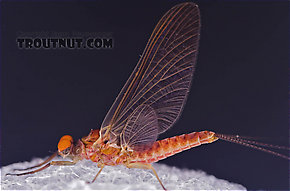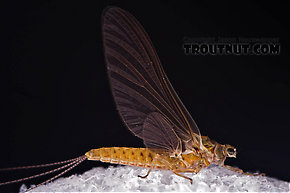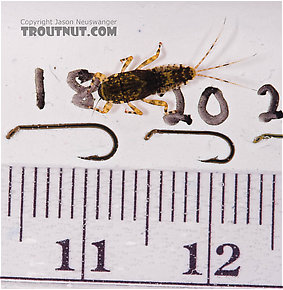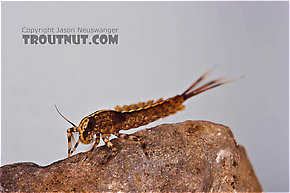Blog & Latest Updates
Fly Fishing Articles
Insects by Common Name


> > The Beaverkill River
The Beaverkill is perhaps the most famous fly fishing stream in America, largely because of its history, and it can still be a good one if you don't let its history spoil your expectations.
Almost every pool has a name and a story or three in the great works of fly fishing literature.
Landscape & scenery photos from the Beaverkill River

This is Cairn's Pool on the Beaverkill, possibly the most famous pool in all of trout fishing.
StateNew York
LocationBeaverkill River
Date TakenMar 22, 2005
Date AddedFeb 1, 2006
AuthorTroutnut
CameraCanon EOS 20D

This 15" brown trout took a small emergent sparkle pupa on a large Catskill river.
StateNew York
LocationBeaverkill River
Date TakenAug 24, 2004
Date AddedJan 25, 2006
AuthorTroutnut
CameraOlympus C740UZ

I'm breaking my rule about naming locations for this picture, since the context adds much to its meaning. This great blue heron is standing on a slab of river-worn concrete silhouetted against the NY Quickway bridge over the Beaverkill River at Cairn's Pool. Several human fishermen pursue trout from one shore while an avian fisherman pursues them from the other.
StateNew York
LocationBeaverkill River
Date TakenOct 9, 2004
Date AddedJan 25, 2006
AuthorTroutnut
CameraOlympus C740UZ

StateNew York
LocationBeaverkill River
Date TakenOct 9, 2004
Date AddedJan 18, 2006
AuthorTroutnut
CameraOlympus C740UZ

Here's an underwater post-release picture of a 15" brown trout I caught in a clear Catskill river.
StateNew York
LocationBeaverkill River
Date TakenAug 24, 2004
Date AddedJan 25, 2006
AuthorTroutnut
CameraOlympus C740UZ
On-stream insect photos from the Beaverkill River

Caddis on Catskill cobble.
StateNew York
LocationBeaverkill River
Date TakenApr 16, 2005
Date AddedFeb 2, 2006
AuthorTroutnut
CameraCanon EOS 20D

StateNew York
LocationBeaverkill River
Date TakenMay 7, 2005
Date AddedMar 25, 2006
AuthorTroutnut
CameraCanon EOS 20D

An ant struggles to escape the surface of a Catskill stream. The black dot on the right is the ant's shadow on a rock on the bottom. I can see how this would appeal to a trout. Even I kind of want to eat the thing.

I'm not sure what the caddisflies in this tight cluster are doing, but I'd guess it has something to do with mating. They scooted all around the rock, with some flies leaving the cluster and new ones coming all the time.
StateNew York
LocationBeaverkill River
Date TakenMar 22, 2005
Date AddedJan 24, 2006
AuthorTroutnut
CameraOlympus C740UZ

I found this little Paraleptophlebia dun along a Catskill stream, but not enough of her brethren were emerging to get the early-season trout to rise.
StateNew York
LocationBeaverkill River
Date TakenMay 7, 2005
Date AddedMar 25, 2006
AuthorTroutnut
CameraCanon EOS 20D
Closeup insects from the Beaverkill River
Male Ephemerella subvaria (Hendrickson) Mayfly Dun View 9 PicturesI collected this male Hendrickson dun and a female in the pool on the Beaverkill where the popular Hendrickson pattern was first created. He is descended from mayfly royalty.
View 9 PicturesI collected this male Hendrickson dun and a female in the pool on the Beaverkill where the popular Hendrickson pattern was first created. He is descended from mayfly royalty.
 View 9 PicturesI collected this male Hendrickson dun and a female in the pool on the Beaverkill where the popular Hendrickson pattern was first created. He is descended from mayfly royalty.
View 9 PicturesI collected this male Hendrickson dun and a female in the pool on the Beaverkill where the popular Hendrickson pattern was first created. He is descended from mayfly royalty.Collected April 19, 2006 from the Beaverkill River in New York
Added to Troutnut.com by Troutnut on April 22, 2006
Added to Troutnut.com by Troutnut on April 22, 2006
Female Ephemerella subvaria (Hendrickson) Mayfly Dun View 9 PicturesI collected this female Hendrickson dun and a male in the pool on the Beaverkill where the popular Hendrickson pattern was first created. She is descended from mayfly royalty.
View 9 PicturesI collected this female Hendrickson dun and a male in the pool on the Beaverkill where the popular Hendrickson pattern was first created. She is descended from mayfly royalty.
 View 9 PicturesI collected this female Hendrickson dun and a male in the pool on the Beaverkill where the popular Hendrickson pattern was first created. She is descended from mayfly royalty.
View 9 PicturesI collected this female Hendrickson dun and a male in the pool on the Beaverkill where the popular Hendrickson pattern was first created. She is descended from mayfly royalty.Collected April 19, 2006 from the Beaverkill River in New York
Added to Troutnut.com by Troutnut on April 22, 2006
Added to Troutnut.com by Troutnut on April 22, 2006
Ephemerella invaria (Sulphur Dun) Mayfly Nymph View 8 PicturesThis small Ephemerella invaria nymph was at least a month away from emergence.
View 8 PicturesThis small Ephemerella invaria nymph was at least a month away from emergence.
 View 8 PicturesThis small Ephemerella invaria nymph was at least a month away from emergence.
View 8 PicturesThis small Ephemerella invaria nymph was at least a month away from emergence.Collected April 19, 2006 from the Beaverkill River in New York
Added to Troutnut.com by Troutnut on April 21, 2006
Added to Troutnut.com by Troutnut on April 21, 2006
Isonychia bicolor (Mahogany Dun) Mayfly Nymph View 7 PicturesThis Isonychia bicolor nymph from the Catskills displays the prominent white stripe sometimes characteristic of its species. This is the first such specimen I've photographed, because members of the same species in the Upper Midwest have a more subdued stripe (and were once thought to be a different species, Isonychia sadleri). The striking coloration on this eastern nymph is more appealing.
View 7 PicturesThis Isonychia bicolor nymph from the Catskills displays the prominent white stripe sometimes characteristic of its species. This is the first such specimen I've photographed, because members of the same species in the Upper Midwest have a more subdued stripe (and were once thought to be a different species, Isonychia sadleri). The striking coloration on this eastern nymph is more appealing.
 View 7 PicturesThis Isonychia bicolor nymph from the Catskills displays the prominent white stripe sometimes characteristic of its species. This is the first such specimen I've photographed, because members of the same species in the Upper Midwest have a more subdued stripe (and were once thought to be a different species, Isonychia sadleri). The striking coloration on this eastern nymph is more appealing.
View 7 PicturesThis Isonychia bicolor nymph from the Catskills displays the prominent white stripe sometimes characteristic of its species. This is the first such specimen I've photographed, because members of the same species in the Upper Midwest have a more subdued stripe (and were once thought to be a different species, Isonychia sadleri). The striking coloration on this eastern nymph is more appealing.Collected April 19, 2006 from the Beaverkill River in New York
Added to Troutnut.com by Troutnut on April 21, 2006
Added to Troutnut.com by Troutnut on April 21, 2006
Brachycentrus appalachia (Apple Caddis) Caddisfly Adult View 5 Pictures
View 5 Pictures
 View 5 Pictures
View 5 PicturesCollected May 7, 2005 from the Beaverkill River in New York
Added to Troutnut.com by Troutnut on May 16, 2006
Added to Troutnut.com by Troutnut on May 16, 2006
Start a Discussion of the Beaverkill River:
Top 10 Fly Hatches
Top Gift Shop Designs
Eat mayflies.
Top Insect Specimens
Miscellaneous Sites
Troutnut.com is copyright © 2004-2024 Jason
Neuswanger (email Jason). See my FAQ for information about use of my images.
 privacy policy
privacy policy
